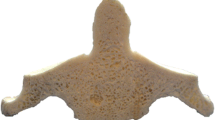Abstract
Introduction
The formation of the occipital bone is intricate and has been extensively studied with many controversial conclusions, but with minimal effort being focused on the genes and molecular interactions necessary for its formation. A better understanding of this bone of the calvarial and skull base may shed light on pathologies where the occiput is often considered the offending entity.
Methods
A review of the germane medical literature using textbooks and standard search engines was performed to gather information about previous conclusions as it pertains to the embryology and ossification of the occipital bone.
Results
The occipital bone has both membranous and cartilaginous origin with ossification occurring as early as week 9 of fetal gestation. Its formations is dependent on complex interacts between genes and molecules with pathologies resulting from disruption of this delicate process.
Conclusion
There has been much controversy in the past in regards to the development and ossification process necessary for occipital bone formation, which has only recently been clarified with documentation of the genes and molecular interactions necessary for its formation. Lastly, this improved knowledge might improve our understanding of such congenital derailments as the Chiari malformations.








Similar content being viewed by others
References
Graham JM (2007) Lambdoidal craniosynostosis. In: Smith’s recognizable patterns of human deformation, 3rd edn. Saunders Elsevier, Philadelphia, pp. 204–209
Hosokawa R, Urata M, Han J, Zehnaly A, Bringas P, Nonaka K, Chai Y (2007) TGF-βmediated Msx2 expression controls occipital somites derived caudal region of skull development. Dev Biol 310:140–153
Huang MH, Gruss JS, Clarren SK, Mouradian WE, Cunningham ML, Roberts TS, Loeser JD, Cornell CJ (1996) The differential diagnosis of posterior plagiocephaly: true lambdoid synostosis versus positional molding. Plast Recontr Surg 98:765–774
Jinkins JR (2000) The skull. Atlas of neuroradiologic embryology, anatomy, and variants. Lipincott Williams and Wilkins, Philadelphia, p. 63
Lee YF, Nimura K, Lo WN, Saga K, Kaneda Y (2014) Histone H3 lysine 36 methyltransferase Whsc1 promotes the association of Runx2 and p300 in the activation of bone-related genes. PLoS One 9(9):e106661. doi:10.1371/journal.pone.0106661
Matsumura G, England MA, Uchiumi T, Kodama G (1994) The fusion of ossification centers in the cartilaginous and membranous parts of the occipital squama in human fetuses. J Anat 185:295–300
Mowbray K (2005) Surface bone histology of the occipital bone in humans and chimpanzees. Anat Rec 283B:14–22
Muhleman M, Charran O, Matusz P, Shoja MM, Tubbs S, Loukas M (2012) The proatlas: a comprehensive review with clinical implications. Childs Nerv Syst 28:349–356
Nayak SR, Krishnamurthy A, Kumar AJ, Probhu L, Jiji P, Pai M, Kumar A, Avadhani R (2007) The mendosal suture of the occipital bone: occurrence in Indian population, embryology and clinical significance. Surg Radiol Anat 29:329–332
Pal GP, Tamankar BP, Routal RV (1984) Bhagwat SS. The ossification of the membranous part of the squamous portion of the occipital bone in man: J Anat 138:259–266
Pang D, Thompson DNP (2011) Embryology and bony malformation of the craniovertebral junction. Child Nerv Syst 27:523–564
Tortori-Donati P, Rossi A (2005) Embryology of the head and neck. Pediatric neuroradiology. Head, neck and spine. Springer, New York, pp. 1257–1264 1271–1272
Shapiro R, Robinson F (1976) Embryogenesis of the human occipital bone. Am J Roentgenol 126:1063–1068
Shoja MM, Tubbs RS, Oakes WJ (2013) Embryology of the craniocervical junction and posterior cranial fossa. The Chiari Malformations. Springer, New York, pp. 13–54
Srivastava HC (1997) Development of ossification centers in the squamous portion of the occipital bone in man. J Anat 124:643–649
Standring S (2015) Gray’s anatomy, 41st edn. Elsevier, Philadelphia
Tubbs RS, Salter EG (2007) Oakes WJ (2007) Does the mendosal suture exist in the Adult? Clin Anat 20:124–125
Tubbs RS, Cesmebasi A, Loukas M, Hogan E, Kralovic S, Cohen Gadol AA (2015) The Chiari malformations: a review with emphasis on anatomical traits. Clin Anat 28:184–194
Tubbs RS, Wellons JC, Smyth MD, Bartolucci AA, Blount JP, Oakes WJ, Grabb PA (2003) Children with growth hormone deficiency and Chiari I malformation: a morphometric analysis of the posterior cranial fossa. Pediatr Neurosurg 38:324–328
Conflict of interest
The authors report no conflicts of interest.
Author information
Authors and Affiliations
Corresponding author
Rights and permissions
About this article
Cite this article
Bernard, S., Loukas, M., Rizk, E. et al. The human occipital bone: review and update on its embryology and molecular development. Childs Nerv Syst 31, 2217–2223 (2015). https://doi.org/10.1007/s00381-015-2870-8
Received:
Accepted:
Published:
Issue Date:
DOI: https://doi.org/10.1007/s00381-015-2870-8




